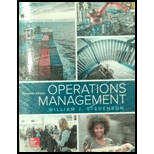
Concept explainers
Introduction:
A baking company situated in New York employs fewer than 200 blue collar employees which has informal atmosphere. The company produces soft cookies over 50 varieties. The company has niche segment of customers promising high quality biscuits. Most of the patrons are over the age of 45 and prefer soft and non-sugary cookies.
The production process begins as soon as the management gets the order from its distributors. The production follows batch processing system. The list of cookies to be made is fed into the system by the personnel in charge and the system evaluates the quantity of ingredients to be mixed. The process is followed by a giant machine where additional products are mixed, baked, cooled and tested to check the quality. Finally the cookies are boxed and labeled automatically.
The manufactured cookies are shipped instantaneously due to the perishable nature. The cookies are tested for its quality by a testing inspector. X-ray test is also done to detect the existence of any foreign materials inside the cookies.
The company takes extra care to reduce the scrap formation and gets inputs from its customer for further potential developments.
To determine: The rightness behind the decision of not implementing automation in packing the cookies and reason behind it. Does Company have any obligations towards its employees and to its community and the size is taken as a factor for consideration? Whether there is a difference when the company is situated in a large city and the size of the company matters? The change in decision if the company size is much larger?
Want to see the full answer?
Check out a sample textbook solution
Chapter 2 Solutions
Loose Leaf for Operations Management (The Mcgraw-hill Series in Operations and Decision Sciences)
- What does a Balanced Workout plan ensure comprehensive fitness? What are the obstacles involved in a Balanced Workout plan to ensure comprehensive Fitness? How does mental well-being entail implementing techniques such as mindfulness, therapy, physical activity, and social support to cultivate emotional resilience and mitigate stress?arrow_forwardIdentify the ethical principles that apply to the case. Include in your discussion how each of the principles of ethical decision making as discussed in the “Underlying Principles of Ethical Patient Care” chapter factored into your decision (beneficence, non-maleficence, autonomy, respect for dignity, veracity, and justice).arrow_forwardWhat should I do? Generate Potential Actions. Include choices that cannot be justified. What justifies my choice? Decide on proper ethical action and generate responses to those with opposing arguments (Justification for your choice)arrow_forward
- in the 2016 "ATB: Digital Disruption in the parking meter industry" case what recommendations would you give to adress the key issues outlined in the case?arrow_forward1) JIT McDonald’s Style (https://media.gaspar.mheducation.com/GASPARPlayer/play.html?id=46KGfedfilYlJzWH4XxxbLS) What challenges did McDonald’s face with its current operating system? 2. What are the five criteria that McDonald’s new “Made for You” operating system had to meet? 3. Describe how the “Made for You” operating system works.arrow_forwardThe first general topic debated in the SHRM Learning System centers around talent acquisition and retention. Discuss how talent is different from skills, and offer two strategies a human resources professional can pursue to recruit “talent” to an organization.arrow_forward
- What assumptions or biases do you have related to the case? Gather the facts. Known and to be gathered. Identify the stakeholders and their viewpoints. Include the values, obligations and interests of each of the stakeholders. Primary Secondaryarrow_forwardPerform an internal analysis using SWOT and VRIO analysis of the " ATB: Digital disruption in the parking meter industry" casearrow_forwardPerform a External analysis using PESTEL and Porters five force analysis on the "ATB: Digital disruption in the parking meter industry" casearrow_forward
- There was a most recent poll for which 571 adults that flew in the past year had info collected. This info was their number 1 complaints about flying. A - small cramped seat - 45 complaints B - cost - 18 complaints C - fear or dislike - 81 complaints D - security - 123 complaints E - Poor service - 12 complaints F - Conntected flight issue - 8 complaints G - overcrowded - 41 complaints H - Late and wait - 81 complaints I - Food - 5 complaints J - Lost/missing luggage - 5 complaints K - Other - 51 complaints What percentage of those surveyed found nothing they didnt dislike?arrow_forwardCan you help me with this, and explain what a product by value analysis is? Thanks in advancearrow_forwardOperations Management Questionarrow_forward
 Foundations of Business (MindTap Course List)MarketingISBN:9781337386920Author:William M. Pride, Robert J. Hughes, Jack R. KapoorPublisher:Cengage Learning
Foundations of Business (MindTap Course List)MarketingISBN:9781337386920Author:William M. Pride, Robert J. Hughes, Jack R. KapoorPublisher:Cengage Learning Management, Loose-Leaf VersionManagementISBN:9781305969308Author:Richard L. DaftPublisher:South-Western College Pub
Management, Loose-Leaf VersionManagementISBN:9781305969308Author:Richard L. DaftPublisher:South-Western College Pub Purchasing and Supply Chain ManagementOperations ManagementISBN:9781285869681Author:Robert M. Monczka, Robert B. Handfield, Larry C. Giunipero, James L. PattersonPublisher:Cengage Learning
Purchasing and Supply Chain ManagementOperations ManagementISBN:9781285869681Author:Robert M. Monczka, Robert B. Handfield, Larry C. Giunipero, James L. PattersonPublisher:Cengage Learning



